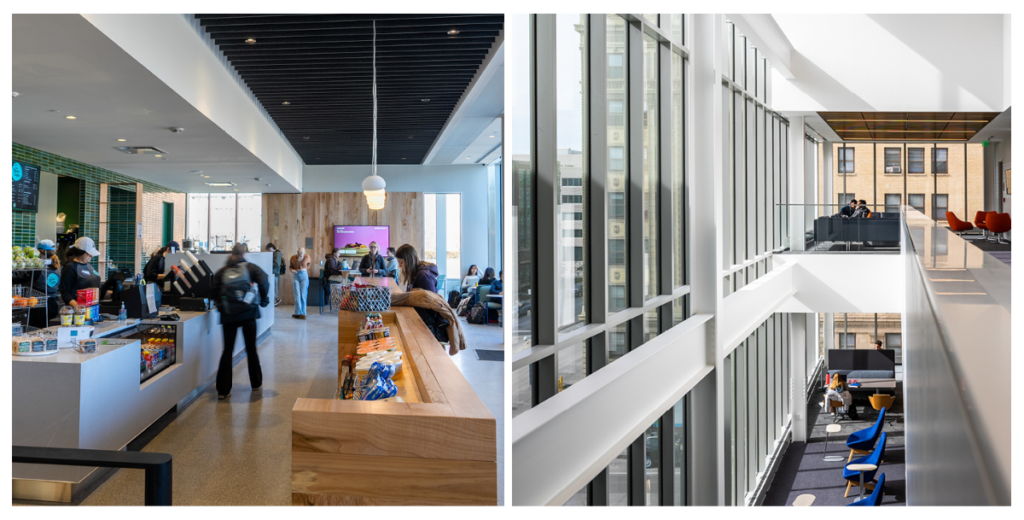It’s a new era for the College of Business Administration. The Dr. E.J. and Margaret O’Brien Hall is here as the inviting, state-of-the-art home for Marquette Business and innovation leadership programs — and more transformative projects are on the way.
In January, Dr. E. J. and Margaret O’Brien Hall opened its doors, the new home of Marquette Business and innovation leadership programs.
“This is the most state-of-the-art college of business in the country,” says acting James H. Keyes Dean Tim Hanley. “It’s a game-changer that will enable our student-focused strategy.”
Located at the high-profile corner of 16th Street and Wisconsin Avenue, the building is the bustling centerpiece of a growing college that enrolls the second-largest number of undergraduates at Marquette and boasts highly ranked programs in finance, supply chain, real estate and other specialties. A gathering place for the campus community and the business community, it’s where Marquette is defining the future of business education — with cutting-edge technology, modern classrooms, amenities tailored to student needs and unique opportunities for students from business and beyond to learn to lead cross-disciplinary innovation in tomorrow’s workplaces.
Here are highlights of the new space:
A new energy
Mike Stern, Eng ’10, senior project manager at J.H. Findorff & Son, has overseen multiple Marquette construction projects, including this one. As he helped O’Brien Hall take shape, he appreciated the fresh perspective it brings to an iconic campus location (where McCormick Hall once stood). “When I walk through the building, I appreciate the tall ceilings, open spaces to find a spot to study, the flexibility of the academic spaces and the transparency that all the glass provides,” he says. “Everyone can see and feel the energy of everyone around them.”

Integrating with campus and community
Just a short traverse across Westowne Square from the Alumni Memorial Union, the building welcomes students, alumni and the community. An outdoor patio with fire pits invites interaction, as do a cafe just inside the main doors and flexible meeting rooms that can serve as classrooms or host a dinner. A dynamic donor wall with LED lighting greets those entering the first-floor atrium and tells the story of the college through its history, with updates expected for chapters yet to be written. “The design concept fosters interactions with the community,” says Kathleen Kugi-Tom, a senior project manager for facilities planning and management.

The technology of tomorrow
The importance of supporting online learning became clear during the pandemic. As a result, there are dedicated spaces for faculty to record lectures or podcasts, and smartboards to beam a professor’s notes to remote students. While executive education will primarily be on-site, cameras and LCD screens make it possible to accommodate students or speakers in other cities, states or countries.
Animating the main space of the first floor, the huge scrolling stock ticker of the Applied Investment Management program showcases a signature program where students manage investment portfolios using the latest tools of financial technology.

Open collaboration
The discipline of business requires collaboration and openness. For example, sales and marketing can’t succeed if they’re cut off from what’s happening in supply chain. Investors may fail if they don’t connect with accountants and auditors. With these factors in mind, O’Brien Hall provides for optimal flexibility. Classrooms can be divided or opened up, and seating arrangements — or rearrangements — can accommodate lectures, online learning or group projects. “Straz Hall served us well for 70 years, but how we teach now is different,” Hanley says. “Very few tables and chairs in O’Brien Hall are screwed into floors. We’ve designed it for how professors teach today.”

Student focus
From the first steps one takes in the lobby, there is no doubt that student care is at the heart of the building’s design. The first floor provides wrap-around student support through centralized advising, the Student Success Center and Business Career Center, plus ample seating and study space for students to settle into. “O’Brien Hall centers around collaboration,” says senior Jackson Gearen, who served on a committee to provide student perspective.
“The space is very open, which creates lots of opportunities for students to gather and work on homework or group projects, or grab a cup of coffee together.”
Reaching across disciplines
A spacious interactive classroom on the fourth floor is home to innovation leadership programs including E-Lead, a groundbreaking program that brings together students from business, engineering and other disciplines to build team leadership abilities to complement their academic knowledge. “This is becoming one of the most active learning classrooms on campus,” says Lora Strigens, vice president for planning and facilities management, and university architect. It’s a natural place to foster the work of Innovation Alley, a partnership of the College of Business Administration and Opus College of Engineering to support the innovation lifecycle from product development to go-to-market strategies.
Honoring the Daniels legacy
Longtime faculty member Dr. Joe Daniels, who died in February 2020 just after being named dean, envisioned this building and built support for it. Today, the dean’s office is named after him, and his spirit is felt throughout, including in the pitch pit where students hone their business pitches on peers, professors and outside experts. “This was Joe Daniels’ vision,” says Andy Hunt, Bus Ad ’08, Grad ’13, Vieth Director of the Center for Real Estate, who served on a faculty–student committee convened by Daniels to provide design input. “This is my favorite space in the building.”
100 percent donor funded
Alumni and Marquette supporters stepped up to fund the creation of the $60 million, 109,000-square-foot building. And much of the fundraising even occurred during the COVID-19 pandemic. “The most gratifying part of this project is that it’s 100 percent donor funded,” Hanley says. “Never in our 140-plus year history have we ever had a project of this scale be fully funded by donors.”





